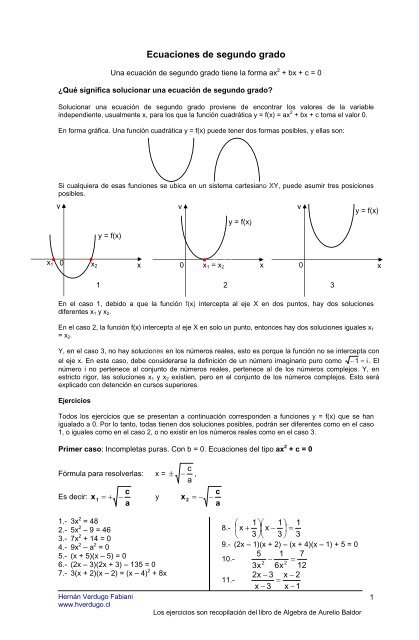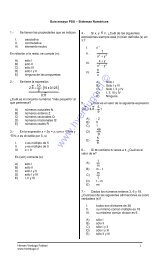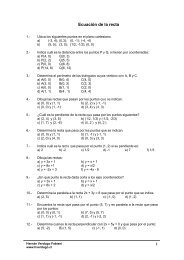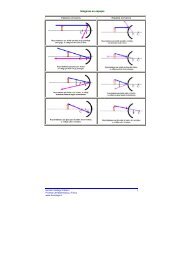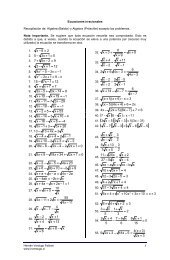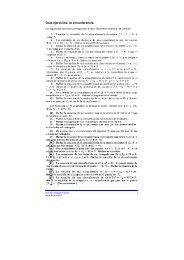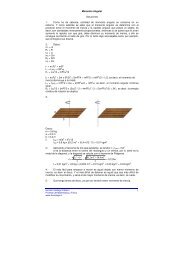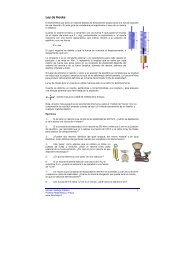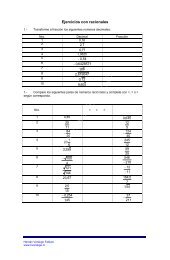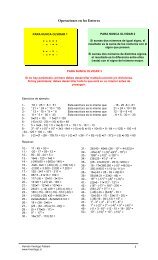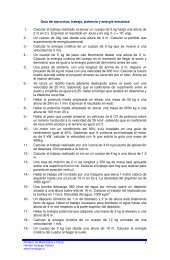Ecuaciones de segundo grado
Ecuaciones de segundo grado
Ecuaciones de segundo grado
Create successful ePaper yourself
Turn your PDF publications into a flip-book with our unique Google optimized e-Paper software.
<strong>Ecuaciones</strong> <strong>de</strong> <strong>segundo</strong> <strong>grado</strong><br />
Una ecuación <strong>de</strong> <strong>segundo</strong> <strong>grado</strong> tiene la forma ax 2 + bx + c = 0<br />
¿Qué significa solucionar una ecuación <strong>de</strong> <strong>segundo</strong> <strong>grado</strong>?<br />
Solucionar una ecuación <strong>de</strong> <strong>segundo</strong> <strong>grado</strong> proviene <strong>de</strong> encontrar los valores <strong>de</strong> la variable<br />
in<strong>de</strong>pendiente, usualmente x, para los que la función cuadrática y = f(x) = ax 2 + bx + c toma el valor 0.<br />
En forma gráfica. Una función cuadrática y = f(x) pue<strong>de</strong> tener dos formas posibles, y ellas son:<br />
Si cualquiera <strong>de</strong> esas funciones se ubica en un sistema cartesiano XY, pue<strong>de</strong> asumir tres posiciones<br />
posibles.<br />
y<br />
y<br />
y<br />
y = f(x)<br />
y = f(x)<br />
x 1<br />
• • x 2<br />
En el caso 1, <strong>de</strong>bido a que la función f(x) intercepta al eje X en dos puntos, hay dos soluciones<br />
diferentes x 1 y x 2 .<br />
En el caso 2, la función f(x) intercepta al eje X en solo un punto, entonces hay dos soluciones iguales x 1<br />
= x 2 .<br />
Y, en el caso 3, no hay soluciones en los números reales, esto es porque la función no se intercepta con<br />
el eje x. En este caso, <strong>de</strong>be consi<strong>de</strong>rarse la <strong>de</strong>finición <strong>de</strong> un número imaginario puro como − 1 = i . El<br />
número i no pertenece al conjunto <strong>de</strong> números reales, pertenece al <strong>de</strong> los números complejos. Y, en<br />
estricto rigor, las soluciones x 1 y x 2 existien, pero en el conjunto <strong>de</strong> los números complejos. Esto será<br />
explicado con <strong>de</strong>tención en cursos superiores.<br />
Ejercicios<br />
y = f(x)<br />
0 x<br />
0<br />
•<br />
x 1 = x 2 x 0<br />
x<br />
1 2 3<br />
<br />
Todos los ejercicios que se presentan a continuación correspon<strong>de</strong>n a funciones y = f(x) que se han<br />
igualado a 0. Por lo tanto, todas tienen dos soluciones posibles, podrán ser diferentes como en el caso<br />
1, o iguales como en el caso 2, o no existir en los números reales como en el caso 3.<br />
Primer caso: Incompletas puras. Con b = 0. <strong>Ecuaciones</strong> <strong>de</strong>l tipo ax 2 + c = 0<br />
Fórmula para resolverlas: x =<br />
Es <strong>de</strong>cir:<br />
x 1<br />
c<br />
= + − y<br />
a<br />
c<br />
± − ,<br />
a<br />
x 2<br />
= −<br />
−<br />
c<br />
a<br />
1.- 3x 2 = 48<br />
2.- 5x 2 – 9 = 46<br />
3.- 7x 2 + 14 = 0<br />
4.- 9x 2 – a 2 = 0<br />
5.- (x + 5)(x – 5) = 0<br />
6.- (2x – 3)(2x + 3) – 135 = 0<br />
7.- 3(x + 2)(x – 2) = (x – 4) 2 + 8x<br />
Hernán Verdugo Fabiani<br />
www.hverdugo.cl<br />
⎛ 1 ⎞⎛<br />
1 ⎞ 1<br />
8.- ⎜ x + ⎟⎜<br />
x − ⎟ =<br />
⎝ 3 ⎠⎝<br />
3 ⎠ 3<br />
9.- (2x – 1)(x + 2) – (x + 4)(x – 1) + 5 = 0<br />
5 1 7<br />
10.- − =<br />
2 2<br />
3x 6x 12<br />
2x − 3 x − 2<br />
11.-<br />
=<br />
x − 3 x −1<br />
Los ejercicios son recopilación <strong>de</strong>l libro <strong>de</strong> Algebra <strong>de</strong> Aurelio Baldor<br />
1
12.-<br />
2<br />
2<br />
2<br />
x − 5 4x −1<br />
14x −1<br />
+ − = 0<br />
3 5 15<br />
13.-<br />
2<br />
x + 1<br />
2x − 3 − = −7<br />
x − 2<br />
3<br />
14.- 3 − = 2<br />
2<br />
4x −1<br />
Segundo caso. Incompletas binomiales. Con c = 0. Son <strong>de</strong>l tipo ax 2 + bx = 0<br />
b<br />
Soluciones: x 1 = 0 y x 2 = −<br />
a<br />
1.- x 2 = 5x<br />
2.- 4x 2 = -32x<br />
6.-<br />
x 2 x − 9 3<br />
−<br />
3.- x 2 – 3x = 3x 2 – 4x<br />
3 6<br />
= 2<br />
4.- 5x 2 + 4 = 2(x + 2)<br />
7.- (4x -1)(2x + 3) = (3x + 3)(x – 1)<br />
5.- (x – 3) 2 – (2x + 5) 2 = -16<br />
x + 1 x + 4<br />
8.- = = 1<br />
x −1<br />
x − 2<br />
<strong>Ecuaciones</strong> completas<br />
Caso particular. Con a = 1. Son <strong>de</strong>l tipo x 2 + bx + c = 0<br />
− b ± b<br />
2 − 4c<br />
Fórmula <strong>de</strong> solución: x =<br />
2<br />
2<br />
− b + b − 4c<br />
Es <strong>de</strong>cir: x1<br />
= y<br />
2<br />
1.- x 2 – 3x + 2 = 0<br />
2.- x 2‘ – 2x – 15 = 0<br />
3.- x 2 = 19x – 88<br />
4.- x 2 + 34x = 285<br />
5.- 5x(x – 1) – 2(2x 2 – 7x) = - 8<br />
Caso general. Son <strong>de</strong>l tipo ax 2 + bx + c = 0<br />
Fórmula <strong>de</strong> solución:<br />
− b ±<br />
x =<br />
b<br />
2a<br />
2 −<br />
4ac<br />
x<br />
2<br />
− b −<br />
=<br />
b<br />
2<br />
2<br />
− 4c<br />
6.- x 2 – (7x + 6) = x + 59<br />
7.- (x – 1) 2 + 11x + 199 = 3x 2 – (x – 2) 2<br />
8.- (x – 2)(x + 2) – 7(x – 1) = 21<br />
9.- 2x 2 – (x – 2)(x + 5) = 7(x + 3)<br />
10.- (x – 1)(x + 2) – (2x – 3)(x + 4) – x + 14 = 0<br />
<br />
Es <strong>de</strong>cir:<br />
x<br />
1<br />
2<br />
− b + b − 4ac<br />
= y<br />
2a<br />
x<br />
2<br />
=<br />
− b −<br />
2<br />
b − 4ac<br />
2a<br />
1.- 3x 2 – 5x + 2 = 0<br />
2.- 4x 2 + 3x – 22 = 0<br />
3.- x 2 + 11x = -24<br />
4.- x 2 = 16x – 63<br />
5.- 12x – 4 – 9x 2 = 0<br />
6.- 5x 2 – 7x – 90 = 0<br />
7.- 6x 2 = x + 222<br />
8.- x + 11 = 10x 2<br />
9.- 49x 2 – 70x + 25 = 0<br />
19.- x(x + 3) = 5x + 3<br />
20.- 3(3x – 2) = (x + 4)(4 – x)<br />
21.- 9x + 1 = 3(x 2 – 5) – (x – 3)(x + 2)<br />
22.- (2x – 3) 2 – (x + 5) 2 = - 23<br />
23.- 25(x + 2) 2 = (x – 7) 2 – 81<br />
24.- 3x(x – 2) – (x – 6) = 23(x – 3)<br />
10.- 12x – 7x 2 + 64 = 0<br />
11.- x 2 = - 15x – 56<br />
12.- 32x 2 + 18x – 17 = 0<br />
13.- 176x = 121 + 64x 2<br />
14.- 8x + 5 = 36x 2<br />
15.- 27x 2 + 12x – 7 = 0<br />
16.- 15x = 25x 2 + 2<br />
17.- 8x 2 – 2x – 3 = 0<br />
18.- 105 = x + 2x 2<br />
25.- 7(x – 3) – 5(x 2 – 1) = x 2 – 5(x + 2)<br />
26.- (x – 5) 2 – (x – 6) 2 = (2x – 3) 2 – 118<br />
27.- (5x – 2) 2 – (3x + 1) 2 – x 2 – 60 = 0<br />
28.- (x + 4) 2 – (x – 3) 2 = 343<br />
29.- (x + 2) 2 – (x – 1) 2 = x(3x + 4) + 8<br />
30.- (5x - 4) 2 – (3x + 5)(2x – 1) = 20x(x – 2) + 27<br />
Hernán Verdugo Fabiani<br />
www.hverdugo.cl<br />
Los ejercicios son recopilación <strong>de</strong>l libro <strong>de</strong> Algebra <strong>de</strong> Aurelio Baldor<br />
2
31.-<br />
x 2 x 3<br />
− =<br />
5 2 10<br />
32.-<br />
13 3<br />
4 x − =<br />
x 2<br />
33.-<br />
x 2 x<br />
− = 3(x − 5)<br />
6 2<br />
34.- 1 2 1<br />
(x − 4) + (x − 5) = (x<br />
53)<br />
4 5 5<br />
35.-<br />
5 1<br />
− = 1<br />
x x + 2<br />
36.-<br />
15 11x + 5<br />
− = −1<br />
2<br />
x x<br />
37.-<br />
8x 5x −1<br />
+ = 3<br />
3x + 5 x + 1<br />
38.-<br />
1 1 1<br />
− =<br />
x − 2 x −1<br />
6<br />
39.-<br />
2x − 3 x − 2<br />
1−<br />
=<br />
x + 5 10<br />
40.-<br />
x −13<br />
10(5x + 3)<br />
= 5 −<br />
2<br />
x<br />
x<br />
Resolver mediante procedimiento <strong>de</strong> factorización.<br />
1.- x 2 – x – 6 = 0<br />
2.- x 2 + 7x = 18<br />
3.- 8x – 65 = - x 2<br />
4.- x 2 = 108 – 3x<br />
5.- 2x 2 + 7x – 4 = 0<br />
6.- 6x 2 = 10 – 11x<br />
7.- 20x 2 – 27x = 14<br />
8.- 7x = 15 – 390x 2<br />
9.- 60 = 8x 2 + 157x<br />
10.- x(x – 1) – 5(x – 2) = 2<br />
11.- (x – 2) 2 – (2x + 3) 2 = -80<br />
12.-<br />
6 9 4<br />
− = −<br />
2<br />
x x 3<br />
13.-<br />
x + 2 74<br />
+ x =<br />
x x<br />
<strong>Ecuaciones</strong> literales.<br />
41.-<br />
x x − 2 5<br />
− =<br />
x − 2 x 2<br />
42.-<br />
4 x<br />
1−<br />
3x 20x<br />
−<br />
x −1<br />
4<br />
3<br />
43.-<br />
3x −1<br />
2x 7<br />
− − = 0<br />
x 2x −1<br />
6<br />
44.-<br />
5x − 8 7x − 4<br />
=<br />
x −1<br />
x + 2<br />
45.-<br />
x + 3 5x −1<br />
− = 0<br />
2x −1<br />
4x + 7<br />
46.-<br />
1 1 1<br />
− =<br />
4 − x 6 x + 1<br />
47.-<br />
x + 4 x + 2 1<br />
− =<br />
x + 5 x + 3 24<br />
48.-<br />
5 6 5<br />
− = 3<br />
2<br />
x x + 1 8<br />
49.-<br />
x −1<br />
x + 1 2x + 9<br />
+ =<br />
x + 1 x −1<br />
x + 3<br />
50.-<br />
3 1 1<br />
− =<br />
x + 2 x − 2 x + 1<br />
14.-<br />
2 2x − 5<br />
( x + 2) − = 3<br />
3<br />
15.-<br />
x 3x + 15<br />
+ x =<br />
x − 2 4<br />
16.-<br />
6 4 5<br />
− =<br />
x − 4 x 12<br />
17.- (x – 2) 3 – (x – 3) 3 = 37<br />
18.-<br />
x −1<br />
x + 3<br />
− 2 =<br />
x + 1 3<br />
<br />
19.-<br />
20.-<br />
4x −1<br />
2x + 1<br />
=<br />
2x + 3 6x + 5<br />
3 x + 2 9x + 14<br />
= 5 −<br />
4 12x<br />
1.- x 2 + 2ax – 35a 2 = 0<br />
2.- 10x 2 = = 36a 2 – 3ax<br />
3.- a 2 x 2 + abx – 2b 2 = 0<br />
4.- 89bx = 42x 2 + 22b 2<br />
5.- x 2 + ax = 20a 2<br />
6.- 2x 2 = abx + 3a 2 b 2<br />
7.- b 2 x 2 + 2abx = 3a 2<br />
8.- x 2 + ax – bx = ab<br />
9.- x 2 – 2ax = 6ab – 3bx<br />
10.- 3(2x 2 – mx) + 4nx – 2mn = 0<br />
11.- x 2 – a 2 – bx – ab = 0<br />
12.- abx 2 – x(b – 2a) = 2<br />
13.- x 2 – 2ax + a 2 – b 2 = 0<br />
14.- 4x(x – b) + b 2 = 4m 2<br />
15.- x 2 – b 2 + 4a 2 – 4ax = 0<br />
Hernán Verdugo Fabiani<br />
www.hverdugo.cl<br />
16.- x 2 – (a + 2)x = - 2a<br />
17.- x 2 + 2x(4 – 3a) = 48a<br />
18.- x 2 – 2x = m 2 + 2m<br />
19.- x 2 + m 2 x(m – 2) = 2m 5<br />
20.- 6x 2 – 15ax = 2bx – 5ab<br />
21.-<br />
2<br />
3x a x<br />
+ − = 0<br />
4 2 2a<br />
22.-<br />
2<br />
2x − b 2bx − b<br />
=<br />
2 3x<br />
23.-<br />
a + x a − 2x<br />
+ = −4<br />
a − x a + x<br />
24.-<br />
2<br />
2<br />
x a<br />
=<br />
x −1<br />
2(a − 2)<br />
Los ejercicios son recopilación <strong>de</strong>l libro <strong>de</strong> Algebra <strong>de</strong> Aurelio Baldor<br />
3
2 1<br />
25.- x + = + 2a<br />
26.-<br />
x a<br />
2x − b x<br />
−<br />
b x + b<br />
=<br />
2x<br />
4b<br />
<strong>Ecuaciones</strong> irracionales <strong>de</strong> <strong>segundo</strong> <strong>grado</strong>. Es indispensable comprobar las dos raíces<br />
que se encuentran.<br />
1.- x + 4x + 1 = 5<br />
2.- 2x<br />
− x −1<br />
= 3x − 7<br />
3.- 5 x − 1 + x + 3 = 4<br />
4.- 2 x − x + 5 = 1<br />
5.- 2 x − 1 + x + 3 = 3<br />
6.- x − 3 + 2x + 1 − 2 x = 0<br />
7.- 5 x − 1 − 3 − x = 2x<br />
8.- 3 x + 1 5x = 16x + 1<br />
9.- 2 x + 4x − 3 = 3<br />
<br />
10.- x + 3 +<br />
6<br />
= 5<br />
x + 3<br />
11.- x +<br />
4<br />
= 5<br />
x<br />
12.- 2 x = x + 7 +<br />
8<br />
x + 7<br />
13.- x + x + 8 = 2 x<br />
14.- 6 − x + x + 7 − 12x + 1 = 0<br />
Hernán Verdugo Fabiani<br />
www.hverdugo.cl<br />
Los ejercicios son recopilación <strong>de</strong>l libro <strong>de</strong> Algebra <strong>de</strong> Aurelio Baldor<br />
4


